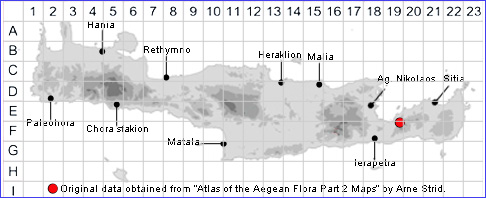SPECIES DESCRIPTION
ASTRAGALUS CRETICUS subsp. MINOICUS
Family and Genus:- See- LEGUMINOSAE/Subgen. TRAGACANTHA
Common Name:- None
Homotypic Synonyms:- None
Meaning:- Astragalus (Gr) Ankle-bone, (a plant with knotted roots).
Creticus (L) From Crete
Minoicus (L) Refers to the ancient Minoan civilization of Crete.
General description:- A perennial shrub with a low-habit, hummock-shaped and
with many branches.
Leaves:-
1) Leaf, 25-50 mm
a) rachis indumentum, scattered, rigid hairs.
b) Leaflets, 8-10 paired, green to green-greyish oblanceolate to elliptic
-oblanceolate, 4-9.5 × 1.5-3.5 mm, densely hairy with mucro 0.1-0.3 mm
4) Stipules, lanceolate, 8-14 mm, uninerved, with few secondary veins, dense
marginal hairs 0.5-0.6 mm long.
Flowers:-
1) Calyx, 9.5-10 mm, totally covered by hairs
a) indumentum, hairs dense, appressed, and undulate, up to 2 mm,
b) teeth, 2.5-3.5 mm, partially hidden by the indumentum.
2) Corolla, pink with purplish veins.
3) Bracts, 7-9 × 1.5-3 mm, obtuse, densely hairy
4) Standard, 14-18 × 5-7 mm
a) wings, 12-13 mm
b) keel, 12.5-13 mm
5) Stamens, 5 mm
a) anthers, ovate, 1 × 0.5 mm.
6) Pistil, 16-17 mm
a) stigma apex, bilobate.
b) style, hairy below.
Fruit:-
1) Legume, 7-8 × 2.5-3
2) Seeds, 3-3.2 × 1.5-1.6 mm, brown, unspotted
Key features:-
1) Corolla, pink with purplish veins.
2) Leaflets, 8-10 paired, green to green-greyish
3) Rachis indumentum, scattered, rigid hairs.
Habitat:- Dry rocky slopes localized exclusively in the sub-montane belt (900–1100
m),
Distribution:- Cretan Endemic. Confined to Afendis Kavousi (Afendis Stavromenos)
Flowering time:- Mid to the end of June to mid-Aug.
Photos by:- Steve Lenton
Taxonomical information:- Kindly supplied by Ralf Jahn

